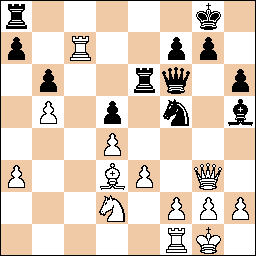Saturday, January 21, 2006
Circle 4 Complete
New look, new attitude. I have been considering changing the look of the blog for awhile, and, after many hours of trial and air playing around with hexadecimal color conversions, you have what you see before you. It fits with the diagrams nicely, but I suspect a few readers won't find it that easy to look at. I even think it takes getting used to. I need to fine tune it a little, like coloring of links in the posts, but I don't have the time right now.
After over a year of daily problem-solving I am loosening up about the scheduling. It will be more like 4-7 days a week, 20 minutes or more if I can. Some of this will have to be opening and other types of study/review. Hopefully this will help get me over the GAG factor which returned a little after subsiding during the recent review circles. Also I am shifting into memorization mode with TCT, and the final circles will be more like mini-circles.
After all these months, I still cannot really tell anyone whether or not going the long route with TCT has forced me to learn it better. Seeing a 1900 player go over a game with someone brought home how incredibly minuscule my improvement is the larger scheme of things, that is when compared with most 1800 + folks. In that light, avoiding early memorization by not doing mini-circles seems a little like nitpicking.
The other big attitude change, or perhaps insistence, is that my chess time be more fun this year.
Lastly, last year Tempo asked me if I had a theory of tactics. I had ideas at the time, but nothing useful or substantive. Now I have something which may be the beginnings of one. It is going to be long, collecting bits of this and that from many months of tactical pondering, put together in typical Spill fashion. Stay tuned for further developments.
;-).
TCT Results | Circle 1 | Circle 2 | Circle 3 | Circle 4 |
| Step 1 | 97% | 99% | 99% | 100%r |
| Step 2 | 93% | 96% | 95% | 97% |
| Step 3 | 93% | 97% | 97% | 96% |
| Step 4 | 80% | 86% | 90% | 92% |
| Step 5 | 74% | 77% | 83% | 86% |
Tuesday, January 17, 2006
Single Line Interference
White to Move

Interference seems much less common than other types of tactics. In the Polgar brick I noticed that when I find interference it usually is when one piece moves onto an intersection line of 2 defenders, simultaneously blocking both lines and making recapture a problem either way (624/5334 for example). I don't know if anyone calls this double line or multiple line interference, but that seems to be a logical term for it.
This tactic has been difficult for me to spot in games, as I expect it is for many beginning and intermediate players. Repeatedly working through examples may be adequate preparation to spot it more regularly in-game, but I wanted to form a better understanding of it. I played around with it, composing some easy examples, breaking it down into simpler parts. This led me to think single line interference was a better starting place than double line interference. It still is messy! I made a less obvious, more complicated example (above). I hope this example shows that just blocking 1 line alone is enough to throw one out of typical move considerations into unnatural but strong sacrifice moves.
Answer: 1.Qd5! Threatening the smothered mate with 2. Nf7#
(1.Nf7+ is more of a mess as in Bxf7 2.gxf7 Nd7 3.Ng6+ Kh7 4.Qxe4 Kh6 5.Bc1+ Bf4 6.Bxf4+ Kh7 7.Nf8+ Kh8 8.Qh7#)
1...Bxd5 A peculiar result of 1.Qd5! is that Black's Rook and c6 pawn can't occupy the d5 square without creating a f7 vulnerability.
2.Rxd5 Threatening again the smothered mate with 3. Nf7#
2...Nd6 Defending f7 at all costs
(2...Rf8 leads to a quicker mate with the clearance move 3.Nf7+ Rxf7 4.Rh5#)
3.Bxd6 this is the fastest way to get rid of the defender and also keep the Rh5# idea going, which is pretty much now unstoppable
3...Rf8 averting mate for just another move
4.Nf7+ Rxf7 5.Rh5#
[Site "?"]
[Date "????.??.??"]
[Round "?"]
[White "New game"]
[Black "Fritz 8"]
[Result "1-0"]
[SetUp "1"]
[FEN "1n1r3k/1nb1N1p1/1pp3P1/6N1/3Qp2P/Bb6/5P2/3R3K w - - 0 1"]
1. Qd5 (1. Nf7+ Bxf7 2. gxf7 Nd7 3. Ng6+ Kh7 4. Qxe4 Kh6 5. Bc1+ Bf4 6. Bxf4+
Kh7 7. Nf8+ Kh8 8. Qh7#) 1... Bxd5 2. Rxd5 Nd6 (2... Rf8 3. Nf7+ Rxf7 4. Rh5#)
3. Bxd6 Rf8 4. Nf7+ Rxf7 5. Rh5# 1-0
Working on this helped me clarify a detail that I never saw fully discussed in any chess book: outnumbering the long-range pieces on a line and perpendicular. Thinking this way, Black could have stopped the Qd5 interference idea by having one more diagonal protector either along the a2-g8 diagonal or a8-h1 diagonal.
I suppose this kind of outnumbering rarely comes up, as it's extremely unlikely to have more than a Queen and Bishop on a diagonal. Another limiting thing for the defender is the difficulty of using pawns; obviously that only works if the square it's protecting is exactly 1 "forward" diagonal square away. Suffice it to say the attacker has a huge advantage, as he can throw pieces onto the interference square from any direction.
-=-=-=-=-
I am still reading the McDonald book incrementally, and I think it's helping. The continuity of moves and plans he describes continues to impress me. In "Game Two" though, his analysis of 28... f6 seemed a little weak, and Fritz confirmed it (thanks PMD for the file). It just shows that Masters are human, as I think he fell out of a vigilant doubting approach and simply argued for Black's move choice.
Back to solving problems. TCT Circle 4's days are numbered...
TCT Results | Circle 1 | Circle 2 | Circle 3 | Circle 4 |
| Step 1 | 97% | 99% | 99% | 100%r |
| Step 2 | 93% | 96% | 95% | 97% |
| Step 3 | 93% | 97% | 97% | 96% |
| Step 4 | 80% | 86% | 90% | 92% |
| Step 5 | 74% | 77% | 83% | 87%* |
Saturday, January 14, 2006
45/45
Here are some other highlights from the current 45/45 tournament (ICC teams) voted by participants:
http://www.teamchess.org/pgnplayer/pgnplayer.php?ID=2949&Board=4
http://teamchess.org/pgnplayer/pgnplayer.php?ID=3096&Board=3
If you have done the circles you probably will find a faster mate just screaming out to be played on this next one:
http://teamchess.org/pgnplayer/pgnplayer.php?ID=3028&Board=4
http://teamchess.org/pgnplayer/pgnplayer.php?ID=2990&Board=2
http://teamchess.org/pgnplayer/pgnplayer.php?ID=3112&Board=4
I plan on reading a few pages a week in the McDonald annotated game book. It is clear just how much more GMs have going on in their games than us amateurs. And sometimes GMs don't have to do very much wrong to earn a '?' from him.
I am going slightly backwards in TCT performance, and I now just hope to end this next section at least 1% greater than last time. Maybe this section warrants a eighth Circle?! Arg.
TCT Results | Circle 1 | Circle 2 | Circle 3 | Circle 4 |
| Step 1 | 97% | 99% | 99% | 100%r |
| Step 2 | 93% | 96% | 95% | 97% |
| Step 3 | 93% | 97% | 97% | 96% |
| Step 4 | 80% | 86% | 90% | 92% |
| Step 5 | 74% | 77% | 83% | 87%* |
Thursday, January 12, 2006
Blitz/Books
1. e4 e5 2. Nf3 Nf6 3. Nxe5 d6 4. Nf3 Nxe4 5. d3 Nf6 6. Bg5 Be7 7. Nc3 O-O
8. h3 h6 9. Bh4 Nc6 10. Be2 Be6 11. d4 Nd5 12. Bxe7 Qxe7 13. Nxd5 Bxd5 14.
O-O Qf6 15. c3 Rae8 16. Re1 Re7 17. Nh2 Rfe8 18. Qd2 Qe6 19. Bf1 Qxe1 20.
Rxe1 Rxe1 21. Nf3 Bxf3 22. gxf3 R8e6 23. Qd3 Rg6+ 24. Kh2 Ree6 25. f4 Ref6
26. Qe3 d5 27. Qe8+ Kh7 28. Bd3 Re6 29. Qxf7 Rf6 30. Bxg6+ Rxg6 31. Qxc7
Na5 32. Qxa5
{Black resigns} 1-0 (pgnviewer.html)
I have been meaning to post something about The Middlegame in Chess by Fine. First is a warning: it has horrible diagram errors! It's obvious that nobody proofread the modern algebraic notation closely, and combined with some pieces out of place it's screwy. I have figured out what moves it was supposed to describe, and it's not a huge problem if I get stumped as most examples are taken from the games of world famous players. The section on mate combinations is vast and much more difficult than I anticipated. This section is organized by kinds of weakened pawns around your opponent's King patterns, and the master games where they capitalize on that in different ways.
I chose to skim over those more difficult parts this time through the book in order to get to the non-mate tactics. I did this because I really help in strengthening my middlegame. I haven't gotten far in this section, but it looks to covers beginner to advanced situations, with some pages taking 15-30 minutes to understand. I almost think of this as a 1950s book version of what CT-Art is for computers today (roughly). All in all, this is a book I expect I will read multiple times.
TCT Results | Circle 1 | Circle 2 | Circle 3 | Circle 4 |
| Step 1 | 97% | 99% | 99% | 100%r |
| Step 2 | 93% | 96% | 95% | 97% |
| Step 3 | 93% | 97% | 97% | 96% |
| Step 4 | 80% | 86% | 90% | 92% |
| Step 5 | 74% | 77% | 83% | 87%* |
Tuesday, January 10, 2006
Multiple Theme Sacrifice
White to Move

Using Burgess's tactical semantics (which seems to differ from others') I see the best line as follows:
Bxg7+
- Clearance along the sixth rank giving the White Rook access to the h6 square
- Destruction of both the Black King's cover and the h6 defender
forcing ...Qxg7
- Deflection of the Black Queen away from its absolute pinning of the White Rook
- Decoy of the Black Queen onto a square that both keeps the Black King hemmed in and puts the Black Queen into an absolute half-pin. (I think "Half-pin" comes from Nimzovich's terminology - means that the pinned piece can move towards the pinning piece.)
Rh6#
This position obviously is artificial, but I found it really difficult to put all 4 of these themes in an example of any kind.
-=-=-=-=-
TCT is going along ok, but I really look forward to being done. I look forward to being in a more balanced study mode, but for now I aim to average 15 minutes a weak opening review.
A blog related thing - Following the trend I have added a RSS feedburner page, although I'm not sure if it was needed. What Druss has going looks nice.
-=-=-=-=-
TCT Results | Circle 1 | Circle 2 | Circle 3 | Circle 4 |
| Step 1 | 97% | 99% | 99% | 100%r |
| Step 2 | 93% | 96% | 95% | 97% |
| Step 3 | 93% | 97% | 97% | 96% |
| Step 4 | 80% | 86% | 90% | 92% |
| Step 5 | 74% | 77% | 83% | 88%* |
Saturday, January 07, 2006
Checkmate Calculation Conundrum
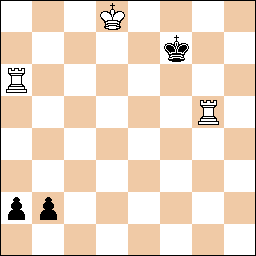
From: Tasc Chess Tutor v2.01, Copyright 1995-1999 Tasc B.V. Holland
Step 5, section 9c, #5
White to Move
This is from a "Test" section, so I had no hint that it was a mate problem. I am down to 4 minutes per problem, though I didn't even use all my time before I started guessing (bad!). Perhaps I was a little tired, but that's not much of an excuse. After not seeing any way to stop both pawns, I just started making lazy mate threats which FINALLY yielded the quiet answer of Rg56. Tricky, huh?
Qxh7 just posted about this, namely how is it that it's difficult to see mate in 2 when you can see easy mates in 3, 4, or even more. In spite of individual differences, I think players experience a similar phenomenon early in there career. To share my take on the whole issue, I have created some relatively simple forced mate examples, all White to move and all with a weak wrong move(s) possible.
- Outnumbering: when cautious middlegame mentality gets in the way. If I ever get good enough to write a tactics book, outnumbering would be the largest chapter. Here are two positions with this theme that seem essentially equivalent to me, the only difference is the second one is difficult for more people to see right away.


Same answer for both positions
Weak move: Rd8+
Answer: Rxh3+ gxh3 Rxh3# - Option Limiting: failing to see a quiet move, prophylaxis, or zugzwang. The second example is a test of finding the absolute best moves for both sides.
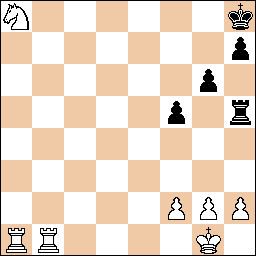
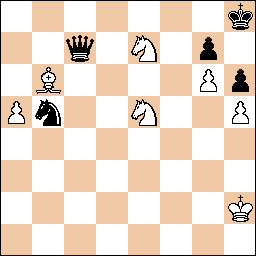
Top postion
Weak move: Rb8+
Answer: Ra7 any Rb8#
Bottom position
Taking the Queen is obvious, so after Bxc7
Weak move: ...Nxc7
Answer: ...Nd6
Now after Bxc7 Nd6 we get
Weak move: Bxd6?? or Nf7? or Kg3?
Answer: Several moves will work-Kh1, a6, Bb8, etc. - Uncommon Final Pattern. The TCT at the top certainly seems uncommon to me.
- Uncommon Tactic: destruction, clearance sacrifice, unusual looking absolute pins, multiple Tactics.

Weak move: just about anything other than the answer.
Answer: Rxc6!. Now ...Bxa4 is the only way to avoid b5#, but leads to Qxa4#
Remedy
I'm not all that experienced like a trainer, but I can speak to what I do. After I follow the forcing checks and moves and not finding the answer, I attempt a few things which have helped me to shift towards the solution in the past:
- Review it. I still make mistakes calculated, so I can tend to go over it again to see if I have messed anything up.
- Break visual attention/move around (like for 30+ seconds). Actually this one has been more helpful than trying to think tactically.
- Look for any possible absolute pin, no matter how unlikely it looks.
- Break the rules. Calculate if you could move on top of or even through your own pieces, or make two moves to achieve mate. This is known as "null move" thinking, and is a powerful optimization in computer chess engines.
- Finally review the "Fundamental Checkmates" and attempt to apply it to the position.
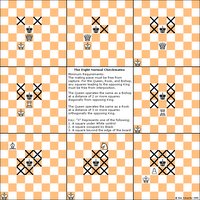
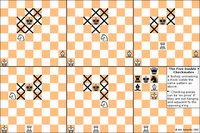
TCT Results | Circle 1 | Circle 2 | Circle 3 | Circle 4 |
| Step 1 | 97% | 99% | 99% | 100%r |
| Step 2 | 93% | 96% | 95% | 97% |
| Step 3 | 93% | 97% | 97% | 96% |
| Step 4 | 80% | 86% | 90% | 92% |
| Step 5 | 74% | 77% | 83% | 88%* |
Friday, January 06, 2006
45/45, Round 3 (ding!)
5. h3 essentially allowed Black to equalize early. 5... c5 would have even been stronger.
I thought 19... e5 (threatening e4) was a great move, but unfortunately White's Knight to b6-e5 gains the d pawn.
I thought about 27...Rd4 but didn't play it fearing mate, but it really was stronger.
28...Here I totally was blind to the open 6th rank mate. I really think I would have seen this OTB as last year I adjusted towards playing long games that way. Another semi-horrible thing to note was that haste was a factor at this point, even with 20 + minutes available on my clock. Having this be a team game made for more pressure, which I really need to set aside. I also need to really follow my own darn advice of "give each position a fresh look".
TCT Results | Circle 1 | Circle 2 | Circle 3 | Circle 4 |
| Step 1 | 97% | 99% | 99% | 100%r |
| Step 2 | 93% | 96% | 95% | 97% |
| Step 3 | 93% | 97% | 97% | 96% |
| Step 4 | 80% | 86% | 90% | 92% |
| Step 5 | 74% | 77% | 83% | 89%* |
Tuesday, January 03, 2006
You make the call
hmmmmmm.........
I just finished the first game in the McDonald book and see why it's recommended. This is the second purely annotated games book I have read, and it would appear an excellent follow up to my first book which was Logical Chess, Move by Move. That was one of the first books I ever read on chess, which was several years ago. McDonald chose dynamic, tension filled games, and describes the plans and threats so that an intermediate player can readily understand. My games seem to contain shallow, half-semi-plans in comparison. I can see why so many people recommend going through Master games for improvement.
P.S. I decided to post more about the first annotated game in McDonald's book.
link
Ok. Here we go. At position I can see 26... Re7 27. Qa8+ Re8 28. Rd8 but then what?
[FEN "4rk2/2pR1prp/pq2b2N/1p6/8/2P2Q2/PP4PP/5R1K b - - 0 26"]
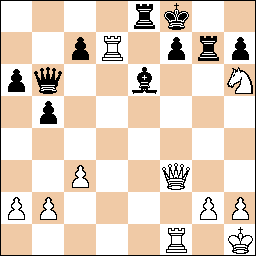
28...Rxg2 was the only thing I could come up with, awful though it appears. It turns out that the best line is 28...Bd7 29.Re1!, which was an eye opener. It would have been nice if he included that little extra bit as the text move is not stronger than this line.
TCT Results | Circle 1 | Circle 2 | Circle 3 | Circle 4 |
| Step 1 | 97% | 99% | 99% | 100%r |
| Step 2 | 93% | 96% | 95% | 97% |
| Step 3 | 93% | 97% | 97% | 96% |
| Step 4 | 80% | 86% | 90% | 92% |
| Step 5 | 74% | 77% | 83% | 89%* |
Sunday, January 01, 2006
New Books
Addendum: Silman's "Rules of Recognition" seems to be largely lifted out of The Middlegame in Chess, pg. 18.
TCT Results | Circle 1 | Circle 2 | Circle 3 | Circle 4 |
| Step 1 | 97% | 99% | 99% | 100%r |
| Step 2 | 93% | 96% | 95% | 97% |
| Step 3 | 93% | 97% | 97% | 96% |
| Step 4 | 80% | 86% | 90% | 92% |
| Step 5 | 74% | 77% | 83% | 90%* |
